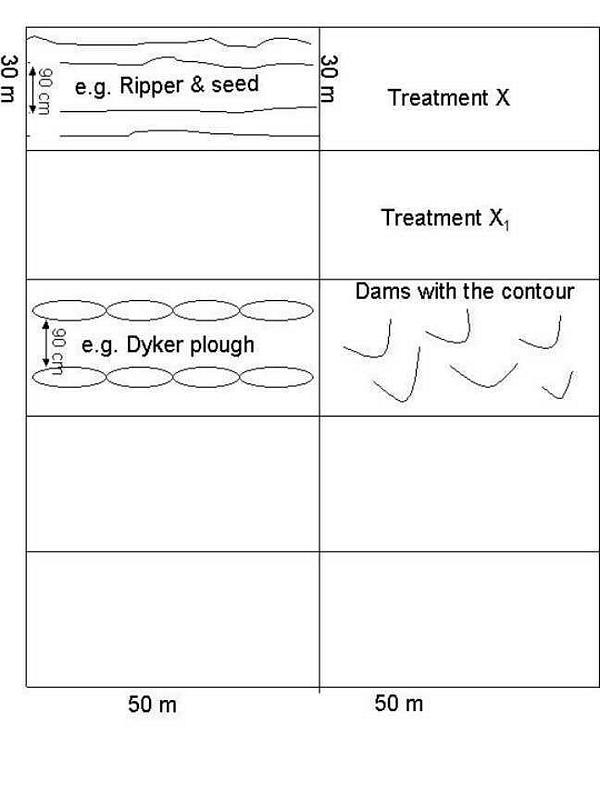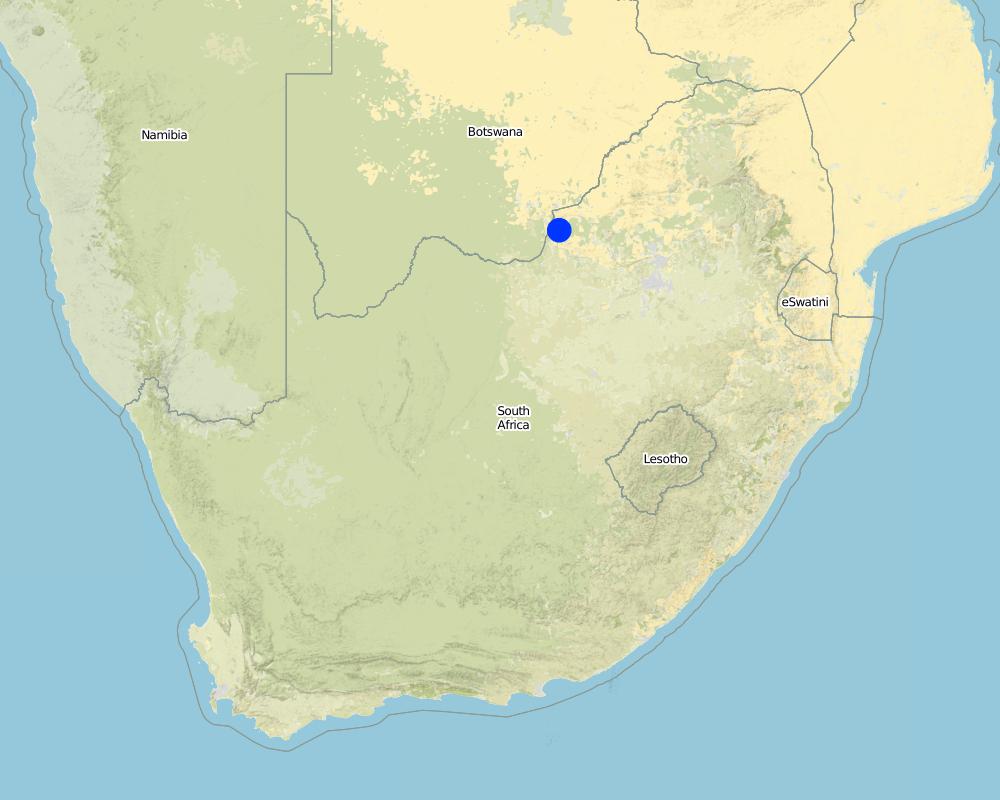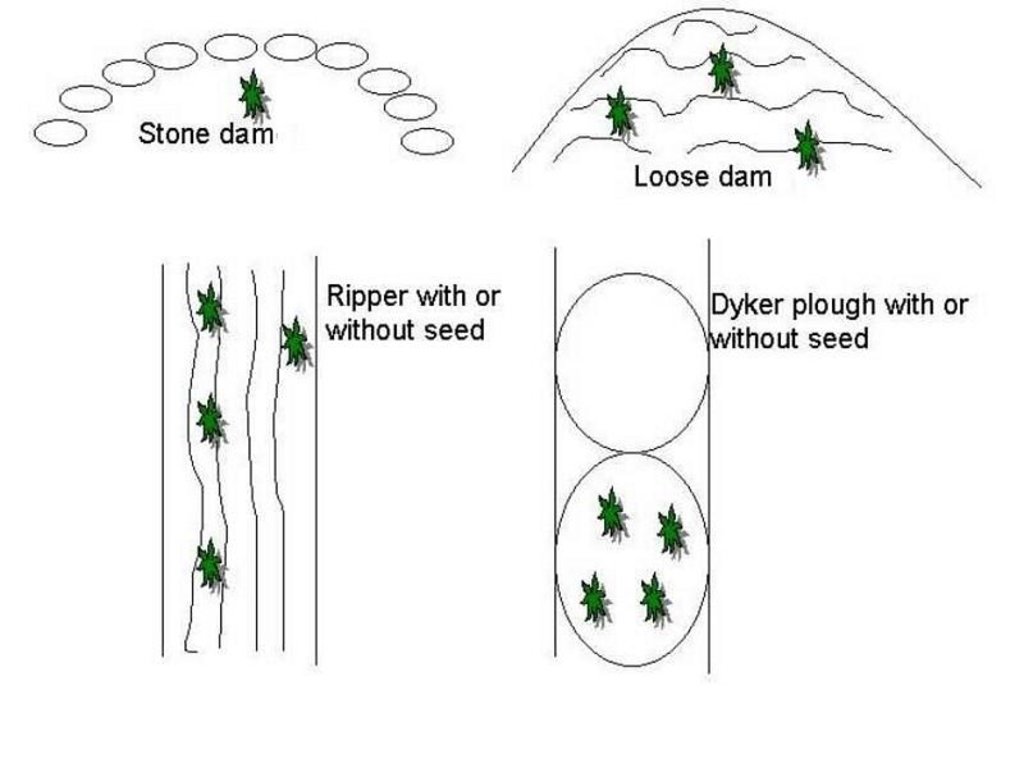Rangeland Rehabilitation [South Africa]
- Creation:
- Update:
- Compiler: Franci Petra Jordaan
- Editor: –
- Reviewers: David Streiff, Alexandra Gavilano
Grazing land (vegetative) combined with management education
technologies_1379 - South Africa
View sections
Expand all Collapse all1. General information
1.2 Contact details of resource persons and institutions involved in the assessment and documentation of the Technology
SLM specialist:
Van Rooyen Jaco
Department of Agriculture, North West Province
South Africa
Name of the institution(s) which facilitated the documentation/ evaluation of the Technology (if relevant)
Dept of Agriculture North West Province (Dept of Agriculture North West Province) - South Africa1.3 Conditions regarding the use of data documented through WOCAT
The compiler and key resource person(s) accept the conditions regarding the use of data documented through WOCAT:
Yes
2. Description of the SLM Technology
2.1 Short description of the Technology
Definition of the Technology:
Rangeland rehabilitation where we use perennial grasses to rehabilitate the footslopes in a semi-arid region on a clay loam soil
2.2 Detailed description of the Technology
Description:
Different techniques (mechanical: e.g. ripper, dyker plough) as well as biological (stone dams, loose dams) are used to rehabilitate a totally degraded area. Different combinations are also used: e.g., ripper with seed and ripper without seed, to see if there is a natural seed bank left. The research is being done in a semi-arid area and on a footslope (medium depth and clay loam soil). The purpose is to get palatable vegetation back in the area for animal consumption. In the process, erosion is stopped and water run-off decreased. At the same time, the community is also trained and educated regarding management, grazing capacity, etc.
Researchers and technicians of the Provincial Department of Agriculture planted the experiment. The community is always present when any treatment is applied. The area is fenced off and maintained by the Department. The community will take full responsibility of the trial at a later stage. They are very eager to take over and their participation is very good.
2.3 Photos of the Technology
2.5 Country/ region/ locations where the Technology has been applied and which are covered by this assessment
Country:
South Africa
Region/ State/ Province:
RSA32
Further specification of location:
Leharatshe
Specify the spread of the Technology:
- evenly spread over an area
If precise area is not known, indicate approximate area covered:
- < 0.1 km2 (10 ha)
Comments:
Total area covered by the SLM Technology is 0.4 km2.
At Driefontein we do only rangeland rehabilitation. At Middelrand we do a combination of bush control and rangeland rehabilitation. The Driefontein area is representative for more or less the whole province. Small village 1.5 - 2km away from Driefontein. Former homeland (Bophuthatswana)
Map
×2.6 Date of implementation
If precise year is not known, indicate approximate date:
- less than 10 years ago (recently)
2.7 Introduction of the Technology
Specify how the Technology was introduced:
- during experiments/ research
Comments (type of project, etc.):
From the researchers of the Department of Agriculture
3. Classification of the SLM Technology
3.1 Main purpose(s) of the Technology
- reduce, prevent, restore land degradation
- preserve/ improve biodiversity
3.2 Current land use type(s) where the Technology is applied

Grazing land
Extensive grazing:
- Semi-nomadic pastoralism
Animal type:
- goats
- mules and asses
- cattle
Products and services:
- transport/ draught
Comments:
Main animal species and products: Cattle & goats, donkey
Major land use problems (compiler’s opinion): Too many animals for the specific area. No camps - so no form of rotation possible; no management plans - animals can walk and graze where they want to.
Major land use problems (land users’ perception): Need more land so that the animals have a larger area to move in.
Semi-nomadism / pastoralism: Cattle & goats, donkey (transport)
Number of growing seasons per year: 1
Longest growing period in days: 210; Longest growing period from month to month: Oct - Apr
3.5 SLM group to which the Technology belongs
- improved ground/ vegetation cover
- improved plant varieties/ animal breeds
3.6 SLM measures comprising the Technology

vegetative measures
- V2: Grasses and perennial herbaceous plants
Comments:
Type of vegetative measures: scattered / dispersed
3.7 Main types of land degradation addressed by the Technology

soil erosion by water
- Wt: loss of topsoil/ surface erosion
Comments:
Main causes of degradation: over-exploitation of vegetation for domestic use, overgrazing, education, access to knowledge and support services (Lack of knowledge)
3.8 Prevention, reduction, or restoration of land degradation
Specify the goal of the Technology with regard to land degradation:
- restore/ rehabilitate severely degraded land
4. Technical specifications, implementation activities, inputs, and costs
4.1 Technical drawing of the Technology
Technical specifications (related to technical drawing):
Ripper and dyker ploughing with or without seed
Location: Driefontein. North West Province
Technical knowledge required for field staff / advisors: moderate
Technical knowledge required for land users: moderate
Main technical functions: control of concentrated runoff: retain / trap, increase of infiltration
Secondary technical functions: control of raindrop splash, improvement of ground cover
Scattered / dispersed
Vegetative material: G : grass
Number of plants per (ha): 6kg seed
Grass species: Panicum maxium, Chloris gayana, Digitaria eriatha, Chenchrus ciliaris
Gradient along the rows / strips: 0.00%
Author:
Franci Jordaan
4.2 General information regarding the calculation of inputs and costs
other/ national currency (specify):
Rand
If relevant, indicate exchange rate from USD to local currency (e.g. 1 USD = 79.9 Brazilian Real): 1 USD =:
6.0
Indicate average wage cost of hired labour per day:
4.00
4.3 Establishment activities
| Activity | Timing (season) | |
|---|---|---|
| 1. | Fencing of area | 1week (end of growing season) |
| 2. | Application of different techniques (treatments) | 2 weeks (beginning of growing season) |
| 3. | Planting of grass | 2 days (beginning of growing season) |
4.4 Costs and inputs needed for establishment
Comments:
Duration of establishment phase: 12 month(s)
4.5 Maintenance/ recurrent activities
| Activity | Timing/ frequency | |
|---|---|---|
| 1. | Keep fence in tact | /Regularly |
4.7 Most important factors affecting the costs
Describe the most determinate factors affecting the costs:
Labours didn't want any money - they feel that they will reap the benefit in the end.
The implements must come from Potchefstroom which is 300km from the area.
5. Natural and human environment
5.1 Climate
Annual rainfall
- < 250 mm
- 251-500 mm
- 501-750 mm
- 751-1,000 mm
- 1,001-1,500 mm
- 1,501-2,000 mm
- 2,001-3,000 mm
- 3,001-4,000 mm
- > 4,000 mm
Agro-climatic zone
- semi-arid
5.2 Topography
Slopes on average:
- flat (0-2%)
- gentle (3-5%)
- moderate (6-10%)
- rolling (11-15%)
- hilly (16-30%)
- steep (31-60%)
- very steep (>60%)
Landforms:
- plateau/plains
- ridges
- mountain slopes
- hill slopes
- footslopes
- valley floors
Altitudinal zone:
- 0-100 m a.s.l.
- 101-500 m a.s.l.
- 501-1,000 m a.s.l.
- 1,001-1,500 m a.s.l.
- 1,501-2,000 m a.s.l.
- 2,001-2,500 m a.s.l.
- 2,501-3,000 m a.s.l.
- 3,001-4,000 m a.s.l.
- > 4,000 m a.s.l.
5.3 Soils
Soil depth on average:
- very shallow (0-20 cm)
- shallow (21-50 cm)
- moderately deep (51-80 cm)
- deep (81-120 cm)
- very deep (> 120 cm)
Soil texture (topsoil):
- medium (loamy, silty)
Topsoil organic matter:
- low (<1%)
If available, attach full soil description or specify the available information, e.g. soil type, soil PH/ acidity, Cation Exchange Capacity, nitrogen, salinity etc.
Soil fertility is lo because organic material is gone due to overgrazing & water erosion
Topsoil organic matter: No organic matter
Soil drainage / infiltration is poor and there is a very high water runoff
Soil water storage capacity is very low
5.6 Characteristics of land users applying the Technology
Market orientation of production system:
- subsistence (self-supply)
Off-farm income:
- less than 10% of all income
Relative level of wealth:
- poor
Indicate other relevant characteristics of the land users:
100% of the land users are poor and own 100% of the land.
Market orientation of production system: Sunflowers and maize for self subsistence
5.7 Average area of land used by land users applying the Technology
- < 0.5 ha
- 0.5-1 ha
- 1-2 ha
- 2-5 ha
- 5-15 ha
- 15-50 ha
- 50-100 ha
- 100-500 ha
- 500-1,000 ha
- 1,000-10,000 ha
- > 10,000 ha
Comments:
NA
5.8 Land ownership, land use rights, and water use rights
Land ownership:
- communal/ village
Land use rights:
- communal (organized)
6. Impacts and concluding statements
6.1 On-site impacts the Technology has shown
Socio-economic impacts
Production
fodder production
Comments/ specify:
From no grass to fodder for the animals
fodder quality
Income and costs
workload
Other socio-economic impacts
input constraints
Socio-cultural impacts
community institutions
national institutions
SLM/ land degradation knowledge
Ecological impacts
Water cycle/ runoff
surface runoff
Quantity before SLM:
90
Quantity after SLM:
50
excess water drainage
Soil
soil moisture
soil cover
soil loss
Quantity before SLM:
4
Quantity after SLM:
1
Climate and disaster risk reduction
wind velocity
Other ecological impacts
soil fertility
biodiversity
6.4 Cost-benefit analysis
How do the benefits compare with the establishment costs (from land users’ perspective)?
Short-term returns:
very positive
Long-term returns:
very positive
How do the benefits compare with the maintenance/ recurrent costs (from land users' perspective)?
Short-term returns:
positive
Long-term returns:
positive
6.5 Adoption of the Technology
- > 50%
Of all those who have adopted the Technology, how many did so spontaneously, i.e. without receiving any material incentives/ payments?
- 0-10%
Comments:
100% of land user families have adopted the Technology with external material support
6.7 Strengths/ advantages/ opportunities of the Technology
| Strengths/ advantages/ opportunities in the land user’s view |
|---|
| Quickly done |
| Strengths/ advantages/ opportunities in the compiler’s or other key resource person’s view |
|---|
| Quickest way to get more palatable grass, a more economical way |
| Very effective |
| Biological methods |
| Manpower to do it |
| Community was not paid, more sustainable |
6.8 Weaknesses/ disadvantages/ risks of the Technology and ways of overcoming them
| Weaknesses/ disadvantages/ risks in the land user’s view | How can they be overcome? |
|---|---|
| Expensive | |
| It is difficult to get the seed | |
| Seed itself is expensive |
| Weaknesses/ disadvantages/ risks in the compiler’s or other key resource person’s view | How can they be overcome? |
|---|---|
| Community do not have implements | Maybe landcare |
| Lack of knowledge (a lot is needed) | Come and see, learnt a lot by implementing |
| On a bigger scale - fence off more or less impossible - at this stage (can not afford) | Maybe branch packing (enough black thorn bush encroachment) |
| Do not understand the system |
7. References and links
7.1 Methods/ sources of information
Links and modules
Expand all Collapse allLinks
No links
Modules
No modules





